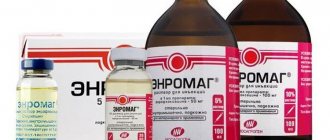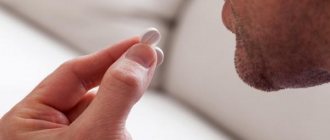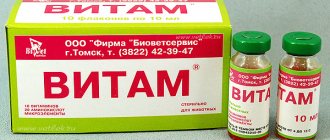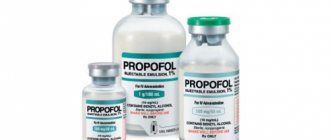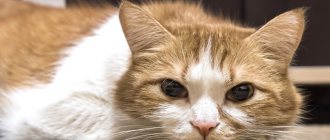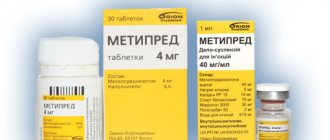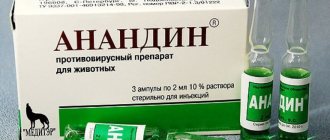- Posted by Olesya Vakhraneva
- Date: December 21, 2018
Aversectin ointment is a proven remedy that can effectively cope with both parasitic insect attacks on cats and tick-borne skin infections. Knowledge of the main characteristics, as well as the features of using the drug, allows you not only to effectively solve the problem, but also to save your budget.
- 2 Mechanism of action of the product
- 3 Indications for use of Aversectin ointment
- 4 How to use the product correctly
4.1 Features of use in kittens and pregnant cats
- 7.1 Table: comparative review of Aversectin ointment with other insectoacaricidal agents
Compound
Aversectin ointment (Unguentum aversektini) has the following composition:
| Description | White-yellow homogeneous mass with an unexpressed “medicinal” odor |
| Concentration of aversectin C (active component) | 0,05% |
| Excipients of the composition | Polyethylene oxide, distilled glycerin |
| Package | Polymer jars 15 ml |
How to use aversectin ointment? Everything is in the instructions for use
Visiting the street with a pet always promises many unpleasant moments. Not only injuries, but also infections of various kinds and parasites. No matter how neat your favorite cat or dog may seem, their special love for sniffing out fresh grass and the marks of other animals poses a threat.
This is not a pathology, but a standard for all animals that communicate with each other using smells and marks. To protect your pet from health problems, veterinary experts recommend the use of aversectin ointment. It is used for all breeds and types of domestic animals.
The first thing every owner must learn is that there is no 100% guarantee that the animal will not pick up a tick or other type of parasite while sitting in the apartment. A person walks down the street and carries all possible bacteria, including parasites, into the house on his shoes. It is quite natural that the pet will check not only the shoes, but also the traces left by its owner. New smells always attract attention.
The second thing you need to know is that it is simply necessary to use drugs to kill bacteria and infections for preventive purposes. But do not overdo it, but strictly follow the instructions for use and regimens recommended to veterinarians. Aversectin ointment is used only for animals. It can be used not only for preventive purposes, but also for medicinal purposes.
The dosage form is suitable for literally everyone:
- cats and cats of all breeds and ages;
- all types of dogs;
- rabbits and parrots;
- fur-bearing animals kept in a house or on a farm.
The main component is aversectin C. It is this that provides high-level therapy. To enhance the main ingredient, the composition included:
- polyethylene oxide-400;
- polyethylene oxide-1500;
- glycerol
But this is only a small part of what the drug consists of. The package insert contains all the necessary information regarding the composition. It should be studied without fail in order to exclude the occurrence of an allergic reaction on the body and in the animal’s body. Use alone is not recommended. Only after diagnosis in the hospital.
Determining the class and group of the drug
The insectoacaricidal drug was included in the group of both systemic and contact action. Which significantly improves its abilities and attracts owners to use it.
What does it mean? Probably the most important thing that interests pet owners is the destruction of sarcoptic ticks at the larval and mature stages.
Also eliminates problems associated with Demodex canis parasites.
Release form
The dosage form is sold only in animal pharmacies. A doctor's referral is not required for purchase. Externally it looks like liquid. The volume of one sold container can be from 15 ml to 500 ml.
The dosage is as follows: 60, 30 and 20 ml. The shelf life is indicated on the packaging. But after opening, proper storage is carried out only in the refrigerator, in a well-closed jar for no more than 2 years.
Availability at a high level - in any veterinary pharmacy in Moscow and other cities of Russia.
Only because of the active component, the ointment has become a significant addition for the rapid recovery of the pet. Aversectin C helps change the level of chloride ions. Penetration of the substance occurs exclusively through the skin and pores.
Quickly enters muscle tissue and neutralizes parasitic creatures. The direct effect occurs initially on chlorine channels (glutamate sensitive) and only then on gamma receptors or aminobutyric acid.
As a result of such reactions, which occur quite quickly, the parasite dies.
Absorption of the drug into the epidermis of the animal occurs within a few seconds after application to the skin. To ensure full impact, the application regimen must not be violated. This is the only way to achieve a high insectoacaricidal effect.
This will help achieve the maximum effect, which occurs within three days. In extreme cases, treatment is extended to a week.
Already 12-14 days after the first application, the dosage form is completely eliminated from the body with feces and urine.
Only because of the active component, the ointment has become a significant addition for the rapid recovery of the pet.
Need to know! All drugs designed to destroy parasitic creatures on a pet’s body contain poisons. They affect not only bacteria and microorganisms, parasites, but also the well-being of the pet. Therefore, you should consult a doctor before use.
There is no need to worry about side effects. Unlike other similar medications, aversectin ointment is completely harmless to your pet, but has a merciless effect on ticks. Possible side effects of most drugs are:
- embryotic and irritating;
- teratogenic and mutagenic;
- sensitizing.
All these effects are eliminated when using aversectin ointment, even with increasing days of therapy. But there is one negative point, according to many owners: the medicine should never be used on humans.
Let's move on to the direct application of this ointment. Application to the epidermis is not difficult at all. And as they say, even a child can cope with this procedure. But there are some precautions to take when preparing for use. Therefore, you should definitely study the recommendations and algorithm offered by the manufacturer.
Step #1
Using a sharp razor, carefully remove all hair from the damaged area of skin. Everything is done slowly so as not to injure the animal. It is advisable to do all the manipulations with an assistant, since the animal always twitches during manipulations that are unpleasant for it.
Step #2
After removing the fur, we move on to processing the epidermis. Needs to be disinfected. Using auxiliary products, remove scabs and dead skin in the form of a crust.
Use softeners if necessary. The process drags on for a long period. Therefore, a muzzle is put on the dog, and an assistant holds small animals. Especially the part of the body where the procedure is taking place.
Let it dry.
The drug is recommended for use not only for tick treatment
Step #3
Take the ointment and after warming it for a short time on your hand, rub it into the skin with massage movements. Use either a spatula, which is applicable in medical practice, or a tampon. Gloves must be worn on hands.
Manipulations are carried out up to 4 times a day with the same time interval. If the course of therapy lasts a week, then the required area is periodically shaved. After complete therapy, a break of up to a week is taken, and an additional course is carried out in a prophylactic direction (3-4 days). Before treating the ears, they are massaged.
If treatment for lice and fleas
The drug is recommended for use not only in anti-tick therapy. It is quite acceptable to begin the treatment process if there is severe flea infestation. To do this, it is not necessary to remove the fur. The only point that will have to be taken into account is whether the cat or dog licks the applied ointment. Therefore, it is better to use other means of destruction yourself. For example, drops.
Purpose and contraindications
The last thing you need to know is contraindications and when is the best time to use the medicine. So, when diagnosing sarcoptic mange, notoedosis, entomosis, demodicosis and otodecosis, the ointment is always useful first. She copes well with the task assigned to her and eliminates problems.
But it is worth remembering that any animal is prone to allergic manifestations. Throughout the course, the pet’s behavior and skin are carefully studied. Obvious contraindications include:
- The age of the fluffy ball is up to 2 months. Birds also count;
- pregnancy and lactation period;
- infectious diseases and adaptation time after a long illness;
- exhaustion, both nervous and nutritional.
Adblock detector
Source: https://petse.ru/kosh/lek_prep/aversektinovaya-maz.html
Pharmacological properties
Aversectin ointment belongs to insectoacaricidal drugs of contact and systemic action, and is part of the class of macrocyclic lactones. It contains aversectin C, which is active against larvae and mature individuals of sarcoptic and demodectic mites, parasitic insects, fleas in dogs, fur-bearing animals, cats, and rabbits.
The active component affects the current of chlorine ions through the membranes of nerve or muscle cells of the parasite. The main target is glutamate-sensitive chloride channels, gamma-aminobutyric acid receptors. A change in the current of chlorine ions disrupts the conduction of nerve impulses, which ends in paralysis and death of the parasite.
When applying the ointment to the skin, aversectin comes into contact with ectoparasites in the hair follicles and sebaceous glands. 3-5 days after the start of use of the product, its maximum serum concentration is reached. Residues are excreted unchanged in feces after 10-12 days.
The drug is a low-hazard substance; in the doses recommended by the instructions, it does not have irritating, sensitizing, resorptive-toxic, embryotoxic, mutagenic, or teratogenic effects. It is well tolerated by dogs, rabbits, and cats, but is toxic to bees, fish, and other aquatic organisms.
When should it not be used?
Allergies occur not only in people, but also in animals. So the main limitation to use is increased sensitivity to the chemicals contained in the drug.
Should not be used under any circumstances when:
- the cat has been diagnosed with infectious diseases;
- the animal you want to treat is less than two months old;
- the animal is undergoing a rehabilitation period;
- an animal in a state of pregnancy;
- Your pet has been identified as having an individual intolerance to this medication (in the first place, this is why you need to consult a good professional doctor).
Most often, however, this medicine is tolerated well by pets and without allergy attacks. But if an allergic reaction does occur, it is usually vomiting, irritation, or a pinkish-pale or red rash on the cat’s skin. If you notice this, you should immediately stop using aversectin ointment and immediately inform your doctor.
IMPORTANT! Also, aversectin ointment cannot be combined with other anti-parasite agents and medications that already include aversectin as an active ingredient.
Directions for use and dosage
If an animal is sick with demodicosis, notoedrosis or sarcoptic mange, the hair in the affected areas is cut off, crusts and scabs are removed, then a thin layer of medicine is applied with a cotton-gauze swab, evenly distributed from the periphery to the center, rubbed into the affected areas, capturing a centimeter of healthy skin.
You can also use glass rods or plastic spatulas for application. To prevent the animal from licking the medicine and harming itself, a collar or collar should be put on it, and its mouth should be tied with braid, which can be removed only after the fur has completely dried.
Treatment is carried out 2-5 times with an interval of 5-7 days until the animal fully recovers. You can find out about this by conducting at least 2 studies of scrapings from the affected areas. If the pet has extensive lesions, then treatment is carried out in two doses with a daily interval. First, the ointment is applied to one half, then to the other. For acarosis complicated by the addition of fungus or bacteria, antibiotics, immunomodulatory or antifungal agents are additionally used.
For ear scabies, the external auditory canal is cleaned of crusts and scabs with a damp swab, then the ointment is applied to each ear. You can first melt it and drop it warm into the ear canal. The procedure is carried out 1-2 times with a 5-7 day interval. For complications and otitis, antibiotics and anti-inflammatory drugs are additionally used. The ointment is applied to both ears, even if only one is affected.
For entomosis (trichodectosis, aphanipterosis, linognathosis), the ointment is rubbed into the skin with a brush against the hair growth in places where insects accumulate, after which the hair is combed with a comb. To prevent recurrence of infection, the litter is changed. Repeated treatment is carried out once a month.
Frequency of treatments and interval between them for different animals:
| Animal | Disease | Frequency of application, times | Processing interval, days |
| Rabbits | Psoroptosis | 2 | 5-7 |
| Cats, dogs | Otodectosis, notoedrosis, sarcoptic mange | 2 | 5-7 |
| Entomosis | 2 | 7-10 | |
| Dogs | Squamous form of demodicosis | 3 | 5-7 |
| Pustular form | 7 | 5-7 | |
| Mixed form | 7 | 5-7 |
In case of an overdose, the animal develops weakness, tremors, and salivation. There are no specific antidotes; symptomatic treatment is carried out, aimed at removing the drug from the body.
Feedback from cat owners
The effect appeared almost immediately. It is possible that our case was not too advanced. A black hard layer, similar to dirt - these same mites, began to fall out in small pieces after the cat began to intensively comb the ointment out of its ears. But it still manages to have its effect. Three times was enough to get rid of the parasites. The itching has stopped.
OlgaK12
https://otzovik.com/review_7349176.html
I first tried to treat my cat with drops, but this did not give the desired result, then the veterinarian prescribed us AVERSECTIN OINTMENT. This can be done easily, but you need an assistant - it’s generally impossible for an inexperienced person to do it alone! First, you need to clean your ears with cotton swabs soaked in 3% hydrogen peroxide, then take a small amount of ointment and put it in your ears. The ointment is thick, so you can put it deeper at first, and then massage the ears until the ointment completely melts. This procedure should be done once a week, 3-4 times depending on the condition. We did it 4 times until it was completely cured. The ointment helps much more effectively than drops, my ears are still clean!
babynadka
https://otzovik.com/review_7402.html
special instructions
During the first use and discontinuation of drug therapy, no peculiarities of action were revealed. Special instructions:
- It is necessary to avoid violating the drug dosage regimen, because this will lead to a decrease in effectiveness. If treatment is missed, it should be carried out as soon as possible without changing the dose.
- The ointment must not be combined with avermectin-containing and other antiparasitic agents.
- Slaughter of rabbits for meat is permitted 14 days after processing. If slaughter is forced, the meat is used as feed for fur-bearing animals.
- When working with the drug, you must follow the rules of personal hygiene and safety precautions. The treatment is carried out wearing rubber gloves; you cannot smoke, drink or eat while working; after finishing you need to wash your hands with soap and dry the gloves.
- For 24 hours after treatment, small children should not be allowed near the animal.
- If a person is hypersensitive to the components of the composition, direct contact with the ointment should be avoided. If the medicine accidentally gets on your skin, you need to wash it off with soap and water, and rinse your eyes with plenty of running water. If an allergy develops, you should go to the hospital.
- Empty cans are prohibited from being used for household purposes. They are wrapped in a bag and disposed of.
Indications for use
The drug is used to eliminate:
- otodectosis;
- entomosis;
- notoedrosis;
- sarcoptic mange;
- demodicosis.
The ointment gets rid of a wide range of parasites that cause harm to the animal, causing itching, burning and the appearance of characteristic rashes. The remedy is especially effective against ear mites, lice and fleas that penetrate the skin or attach to its surface.
Ear mites in a cat (multiple increase) is an indication for the use of the drug
Attention! Do not use the ointment without first consulting your veterinarian. Tick infestations are easily confused with other diseases that are similar in course.
Analogs
The product can be replaced with drugs for humans or animals with the same or a different composition, but with a similar effect. Analogues of Aversectin ointment:
- Benzyl benzoate – antiparasitic emulsion and ointment with the same component;
- Lamisil - antifungal spray, cream, tablets based on terbinafine;
- Terbix – gel, cream, ointment, solution, spray with terbinafine;
- Sulsen – paste, shampoo, anti-fungal oil based on selenium disulfide;
- Ketoconazole – antifungal tablets, suppositories, ointment with the same component;
- Itraconazole – capsules with the active ingredient itraconazole, chlorine;
- Myoseptin is an ointment based on undecylenic acid and its zinc salt.


